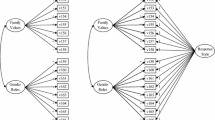Abstract
On the basis of both previous and recent research on intercultural perceptions (Lee & Ottati, 1993; Triandis & Vassiliou, 1967), it is hypothesized that perceived group homogeneity would be intimately related to familial loyalty (or commitment) and stability. A cross-cultural questionnaire study was conducted both in the People’s Republic of China (n=182) and in the United States of America (n=182). The results revealed that both Chinese and American subjects perceived a collectivistic society to have more familial commitment and stability while they perceived an individualistic society to have less familial commitment and stability. The implications for this study have been discussed.
Similar content being viewed by others
References
Allport, G. W. (1954).The nature of prejudice. Mass.: Addison-Wesley.
Bellah, R. N., Madsen, R., Sullivan, W., Swidler, A. & Tipton, S. (1985).Habits of the heart: Individualism and commitment in American life. New York: Harper & Row.
Bond, M. H. (1986).The psychology of the Chinese people. London: Oxford University Press.
Brislin, R. (1986). The wording and translation of research instruments. In W. Lonner & J. Berry (Eds.),Field methods in cross-cultural research. Beverly Hills, CA: Sage.
Brislin, R. (1993).Understanding culture’s influence on behavior. San Diego, CA: Harcourt Brace Jovanovich.
Brodbar-Nemzer, J. Y. (1986). Divorce and group commitment: The case of the Jews.Journal of Marriage and the Family, 48, 329–340.
Buss, David M., et al. (1990). International preferences in selecting mates: A study of 37 cultures.Journal of Cross-Cultural Psychology:21(1), 5–47.
Cherlin, A. & Celebuski, C. (1983). Are Jewish families different? Some evidence from general social survey.Journal of Marriage and the Family, 45, 903–910.
Chu, G. C. (1985). The changing concept of self in contemporary China. In A. J. Marsella, G. DeVos & F. L. K. Hsu (Eds.),Culture and Self (pp. 231–251). New York: Tavistock Publications.
Clark, M. S. & Reiss, H. T. (1988). Interpersonal processes in close relationships.Annual Review of Psychology, 39, 106–172.
Cronbach, L. J. (1951). Coefficient alpha and the internal structure of tests.Psychometrika, 16, 297–334.
D’Antonio, W., Newman, W. & Wright, S. (1982). Religion and family life: How social scientists view the relationship.The Journal of the Scientific Study of Religion, 21, 218–225.
Dion, K. L. & Dion, K. K. (1988). Romantic love: Individual and cultural perspectives. In R. J. Sternberg & M. L. Barnes (Eds.),The psychology of love (pp. 264–289). New Haven: Yale University Press.
Fairbank, J. K. (1987).China watch. Cambridge: Harvard University Press.
Fromm, E. (1956).The art of loving. New York: Harper & Row.
Funder, D. (1987). Errors and mistakes: Evaluating the accuracy of social judgment.Psychological Bulletin, 101, 75–90.
Hsu, F. L. K. (1953).American and Chinese: Two ways of life. New York: Henry Schuman.
Hsu, F. L. K. (1963).Clan, Caste, and Club. New York: D. Van Nostrand Company, Inc.
Hsu, F. L. K. (1983).Rugged individualism reconsidered: Essays in psychological anthropology. Knoxville: The University of Tennessee Press.
Jing, C. C. (1991).Population Planning in the Developing World. Symposium at the 99th Annual Conference of the American Psychological Association, August, San Francisco: CA.
Jussim, L. (1991). Social perception and social reality: A reflection-construction model.Psychological Review, 98, 54–73.
Lee, Y. T. (1991).Psychological Theories in Ancient China: A Historical View. Paper presented at the 99th Annual Convention of the American Psychological Association, August 16–20. CA: San Francisco.
Lee, Y. T. & Ottati, V. (1993). Determinants of ingroup and outgroup perceptions of heterogeneity: An investigation of Sino-American stereotypes.Journal of Cross-Cultural Psychology 24(3), 298–318.
Marsella, A. J., DeVos, G. & Hsu, F. L. K. (1985).Culture and Self. New York: Tavistock Publications.
O’Leary, K. D. & Smith, D. A. (1991). Marital interactions.Annual Review of Psychology, 42, 191–212.
Seligman, M. E. P. (1991).Learned optimism. New York: Alfred Knopf.
Sternberg, R. J. & Barnes, M. L. (1988). (Eds.)The psychology of love. New Haven: Yale University Press.
Triandis, H. C. (1990). Cross-cultural studies of individualism and collectivism. In J. Berman (Ed.),Nebraska symposium on motivation. Lincoln: University of Nebraska Press.
Triandis, H. C., Bontempo, R., Villareal, M. J., Asai, M. & Lucca, N. (1988). Individualism and collectivism: Cross-cultural perspective on self-ingroup relationships.Journal of Personalty and Social Psychology, 54, 323–338.
Triandis, H. C., McCusker, C. & Hui, C. H. (1990). Multi-method probes of individualism and collectivism.Journal of Personality and Social Psychology, 59(5), 1006–1020.
Triandis, H. C. & Vassiliou, V. (1967). Frequency of contact and stereotyping.Journal of Personality and Social Psychology, 7(3), 316–328.
Tu, W. M. (1985). Selfhood and Otherness in Confucian Thought. In A. J. Marsella, G. DeVos & F. L. K. Hsu (Eds.)Culture and Self (pp. 231–251). New York: Tavistock Publications.
Tu, W. M. (1991). Cultural China: The periphery as the center.Daedallus: Journal of the American Academy of Arts and Sciences, Spring, 1991.
Yang, K. S. (1986). Chinese personality and its change. In M. H. Bond (Ed.),The psychology of the Chinese people (pp. 106–170). London: Oxford University Press.
Yee, A. H. (1989).A people misruled: Hong Kong and the Chinese stepping stone syndrome. Hong Kong: APL Press.
Wright, J. (1992).The Universal almanac: 1992. Kansas City, Missouri: Andrews & McMeed.
Author information
Authors and Affiliations
Rights and permissions
About this article
Cite this article
Lee, YT. Perceived homogeneity and familial loyalty between Chinese and Americans. Current Psychology 12, 260–267 (1993). https://doi.org/10.1007/BF02686807
Issue Date:
DOI: https://doi.org/10.1007/BF02686807




